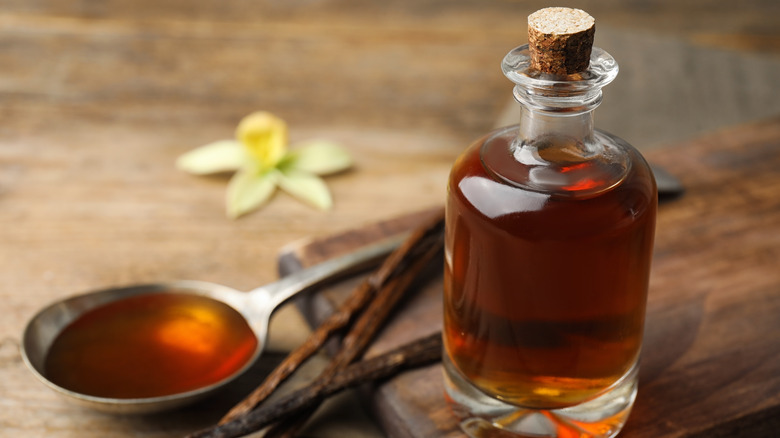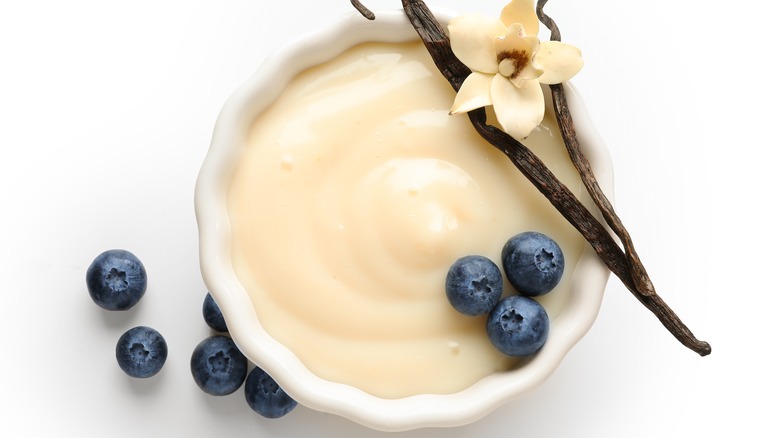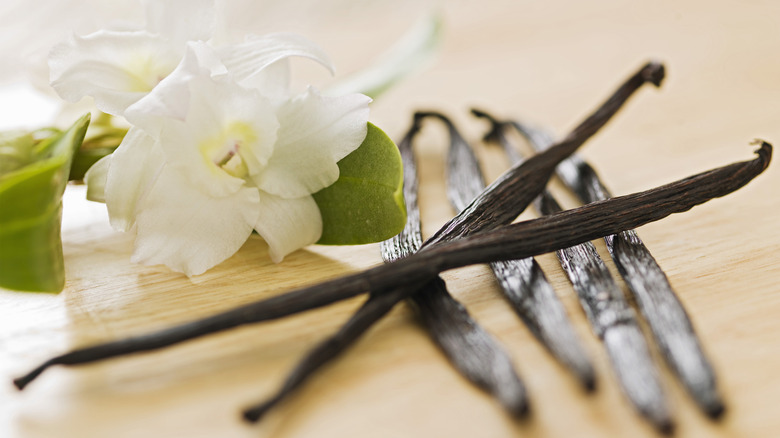It Isn't Always A Sin To Use Fake Vanilla In Your Desserts
With every trip to the supermarket, we're reminded of the unfortunate truth that grocery prices are on the rise. Of course, you can mitigate some of these crushing costs by sticking to generic brands, and fortunately, there are inexpensive alternatives to many foods and ingredients that are just as good as the real deal. Before you start to stuff your grocery basket with cheap knockoffs, you should be aware of which grocery items are worth the splurge.
Pure vanilla extract is one of the products that many bakers would argue is one of these items, because its real vanilla bean base imparts a much more complex flavor to your sweet treat, where the imitation iteration only delivers a punch of pungent vanilla flavor. If you want to bake like a pro using vanilla, while still sticking to your budget, being aware of when it's acceptable to use imitation vanilla is of the utmost importance. So it's good to know that under certain baking conditions and with some flavor combinations, fake vanilla delivers the taste you want.
When to use imitation vanilla extract
When it comes time to choose which vanilla flavor addition to use, one of the key influencing factors will be the temperatures that your baked goods will be exposed to in the oven. Desserts that require lower temperature bakes, like custard, will allow the vanilla extract's flavor to remain intact. Cookies, on the other hand, will be cooked to a higher internal temperature. In blind studies, taste testers preferred the imitation vanilla version of the cookie better, noting it had more vanilla flavor. In many cases, vanilla extract is used in small quantities in baked goods as a flavor enhancer for other ingredients like chocolate or fruits, so the fake stuff is fine there too.
If you're making a sweet treat that is strictly vanilla in flavor, or a chilled dessert like ice cream, using real-deal vanilla is the superior option. Without competing flavors being present in the dessert, the depth of flavor present in pure vanilla can really express itself. Fortunately, there's a Costco vanilla extract loved by professional bakers that has a surprisingly low price point.
Before you begin baking, it's worth having a full understanding of your vanilla options. Vanilla bean paste gives the most authentic vanilla flavor of any option, while simultaneously operating as a natural thickening agent. The flecks of vanilla bean seeds in this paste will give your dessert the visual appeal of using a vanilla bean, without the extra work.
The making of real vs imitation vanilla extract
To better understand the sky-high cost of authentic vanilla extract, you need to know how complicated the extraction process is — and that vanilla is the only flavor regulated by the FDA. For starters, pure vanilla is made from vanilla beans, 80% of which are grown on the African island of Madagascar, and as such, inclement weather can radically alter the global supply of vanilla beans. The length of time it takes for vanilla beans to grow, coupled with the time frame of crop cultivation and global distribution, means that pure vanilla extract takes around a year to be distributed. Furthermore, vanilla beans come from a single variety of orchid which only flowers once a year. The crop also has a short time frame for harvesting, which makes it among the most difficult crops in the world to cultivate.
Imitation vanilla uses a synthetic version of vanillin that's made from guaiacol, and guaiacol mostly comes from petroleum. Vanillin is the only ingredient that influences the flavor of imitation vanilla, which means that the faux product is rather one-note. Real vanilla extract and paste have a complex mix of myriad flavors beyond just vanillin. Those with a puritanical position on vanilla extract would be disheartened to know that over 95% of vanilla flavor used in the modern marketplace comes from the fake stuff.


